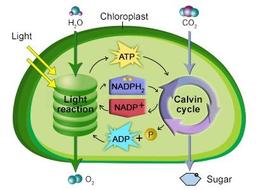
Photosynthesis - Light Independent Reaction
Quiz by Mr R Horn
Feel free to use or edit a copy
includes Teacher and Student dashboards
Measure skillsfrom any curriculum
Tag the questions with any skills you have. Your dashboard will track each student's mastery of each skill.
- edit the questions
- save a copy for later
- start a class game
- automatically assign follow-up activities based on students’ scores
- assign as homework
- share a link with colleagues
- print as a bubble sheet
- Q1
Adding inorganic carbon, in the form of CO2, to an organic compound (RuBP) is termed 'carbon .......?........'
Users enter free textType an Answer60s - Q2
Where does the light independent reaction take place?
matrix
stoma
stroma
thylakoid membranes
60s - Q3
Name the 5-carbon molecule that CO2 binds to during carbon fixation
Users enter free textType an Answer60s - Q4
What is the other name for the light independent reaction?
Unicycle
Calvin cycle
Kreb cycle
Citric acid cycle
60s - Q5
Name the enzyme responsible for binding CO2 to RuBP
Users enter free textType an Answer60s - Q6
What is formed when Rubisco binds CO2 to RuBP?
citrate (citric acid)
Reduced NADP
2x glycerate 3-phosphate (GP)
triose phosphate
60s - Q7
Glycerate 3-phosphate (GP) is .......................................... to form triose phosphate (TP)
reduced
oxidised
60s - Q8
Which molecule provides the reducing power needed to convert glycerate 3-phosphate (GP) into triose phosphate (TP)?
ATP
Reduced NADP (NADPH)
Reduced NAD
Oxidized NADP (NADP+)
60s - Q9
Which molecule provides the energy needed to convert glycerate 3-phosphate (GP) into triose phosphate (TP)?
Reduced NAD
ATP
Reduced NADP (NADPH)
Oxidized NADP (NADP+)
60s - Q10
Apart from converting glycerate 3-phosphate (GP) into triose phosphate (TP), what is ATP made in the Light Dependent Reaction used for?
Regenerating RuBP (from triose phosphate)
Converting triose phosphates into glucose and other organic molecules
Carbon fixation
Active transport
60s - Q11
In Melvin Calvin's experiment, algae was grown in a thin transparent glass vessel. Radioactive carbon (in hydrogen carbonate) was added. This was incorporated into the molecules in the Calvin cycle by ...........
Chemiosmosis
Reduction
Carbon fixation
Oxidation
60s - Q12
In Melvin Calvin's experiment, algae was grown in a thin transparent glass vessel. Radioactive carbon (in hydrogen carbonate) was added. After 5 seconds a sample was removed and dropped into hot methanol. Why?
To stop the chemical reactions instantly, so that the compounds containing radioactive carbon could be identified.
To disrupt the membranes in the algal cells, thereby releasing the key biological molecules.
To dissolve chlorophyll (which is not soluble in water)
To kill any other microorganisms
60s - Q13
In Melvin Calvin's experiment, algae was grown in a thin transparent glass vessel. Radioactive carbon (in hydrogen carbonate) was added. After 5 seconds a sample was removed and dropped into hot methanol. This was repeated at 5s intervals. What is the purpose of this experiment?
To determine how long it takes for one circuit of the Calvin cycle
To measure the rate of photosynthesis in algae
To identify the order of the molecules in the Calvin cycle (eg in the 1st sample the only radiolabelled molecules were GP, so this must be the 1st molecule in the cycle after carbon fixation)
To determine the sequence of the Light Dependent Reaction
60s - Q14
In Melvin Calvin's experiment, algae was grown in a thin transparent glass vessel. Radioactive carbon (in hydrogen carbonate) was added. After 5 seconds a sample was removed and dropped into hot methanol. This was repeated at 5s intervals.
What name was given to this experiment?
The lollipop experiment
The Calvin flask
The candycane experiment
The green glass flask experiment
60s - Q15
In Melvin Calvin's experiment, algae was grown in a thin transparent glass vessel. Radioactive carbon (in hydrogen carbonate) was added. After 5 seconds a sample was removed and dropped into hot methanol. This was repeated at 5s intervals.
Which radioactive isotope of carbon was used?
C14
C13
C12
C6
60s